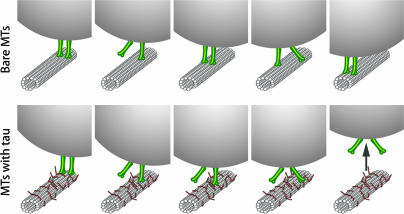Fig. 5.
A model of multiple-motor driven cargo transport. Here we model a two-motor arrangement, the simplest case of multiple motor transport. Higher numbers of motors will not alter the qualitative picture presented below. Note that the actual number of participating motors is not resolved in our experiments for each binding event and for each bead. Rather, we determine the frequency of one, two, and more motor events in a statistical sense for a given bead assay. Without tau (top row sequence), motors frequently detach and reattach; however, at least one motor always tethers the cargo to the MT. In the presence of tau (lower row sequence), rebinding is suppressed. Therefore, once the first motor disengages from the MT, it is unlikely to reattach before the second motor also detaches. The bead then ceases its processive motion and diffuses away (arrow). One important net result of this tau effect is reduced cargo travel distances. Notice also that, by blocking rebinding, tau reduces the number of motors that on average drive the cargo. Therefore, tau is also expected (and indeed observed) to reduce the total force that the motors can apply to move the cargo. Likewise, tau is expected to reduce the force needed to detach the cargoes from MTs, an effect that is indeed observed in our pull-off experiments.

